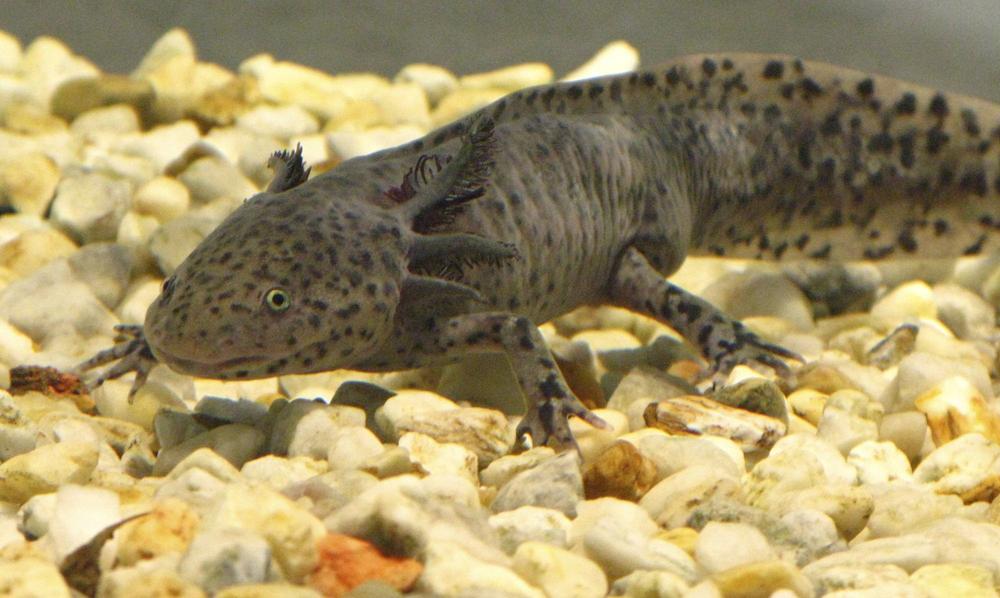
Axolotls are having a moment. From TikTok to Minecraft, these friendly-looking salamanders with frilly gills are showing up everywhere. With their wide-set eyes and constant half-smile, it’s easy to see why they’ve become internet icons. And in aquariums around the world, they’re more popular than ever.
But in the wild, axolotls are dangerously close to disappearing. Their native habitat has shrunk to a single lake system — Xochimilco, just outside Mexico City — where water pollution, habitat loss and invasive species have pushed them to the edge of extinction.
Conservation International is helping to restore the axolotl’s natural habitat by returning to ancestral farming practices. By supporting farmers’ transition to pesticide-free farming and helping install biofilters to clean the water, the project aims to restore these waters so axolotls can thrive into the future.
Continue your quest to become an axolotl aficionado: Learn more about the critically endangered amphibian and share with friends.
Share these facts about axolotls:
Unlike most amphibians, axolotls live their entire lives underwater
Amphibians start life in water, then grow lungs and move onto land, right? Not the axolotl. These salamanders stay in their larval form for life, keeping their gills, tails and aquatic lifestyle — a trait called neoteny.1
Axolotls are common in aquariums — but nearly extinct in the wild
Axolotls are popular pets around the world and have been bred in labs for over a century. But in their natural habitat, they’re critically endangered by urbanization, pollution and invasive species. According to the IUCN Red List2, just 50 – 1,000 may remain in the wild.
The axolotl’s last wild home is an ancient canal system
More than a thousand years ago — centuries before the Aztec Empire — the Xochimilca people built a system of canals and artificial islands to grow crops in the shallow lakes of central Mexico.
Today, the remnants of that system are the only place on Earth where axolotls still live in the wild3. But this habitat is shrinking due to pollution, invasive species and urban sprawl.
Most pet axolotls trace back to a shipment to Paris in 1864
In the 1860s, French naturalists brought 34 live axolotls from Mexico to Paris. The salamanders thrived in captivity and were soon bred in labs and zoos across Europe. Today, most axolotls in aquariums and research labs around the world are descendants of that original group.4
Wild axolotls are brown and speckled — unlike the pink ones you see online
Captive-bred axolotls trace their unique coloring back to a white-colored male from the group brought to Paris in 18644. Over time, selective breeding has led to other color morphs like gold, black and even pale blue.
Axolotls can regrow parts of their body — including their heart and spine
If an axolotl loses a limb, it doesn’t scar — it regenerates. These salamanders can grow back not just legs and tails, but also parts of their heart, spine and even brain5. That’s one reason scientists brought them into labs in the 1800s, and why researchers still study them today.
Axolotls are cannibals
Despite their gentle appearance, young axolotls in captivity will sometimes bite off each other’s limbs — especially in crowded tanks.5 Some scientists believe this may be why axolotls evolved the ability to regenerate lost body parts in the first place.
Axolotls are nearly toothless
Axolotls may nibble on their tankmates, but they’re not doing much chewing. Instead of true teeth, they have tiny ridges that help them grip prey.6 They eat by quickly opening their mouths and sucking in water — along with worms, insects or anything bite-sized that floats by. It’s more vacuum cleaner than vicious bite.
The axolotl genome is 10 times the size of the human genome
The sheer number of axolotl genes7 has made it difficult for researchers to pin down precisely which ones are responsible for the axolotl’s remarkable regenerative properties.
Ancient farming techniques could help save the axolotl
For centuries, Indigenous farmers in central Mexico used a method called chinampas — artificial islands built in shallow lakes — to grow crops. These floating gardens created a rich habitat for wildlife, including the axolotl8. Today, Conservation International is helping local communities revive this technique to support sustainable farming and restore the axolotl’s last habitat.

Axolotl Conservation Status
According to the International Union for Conservation of Nature’s Red List of Threatened Species, the axolotl is listed as critically endangered, with fewer than 1,000 specimens remaining in the wild. But Conservation International is working to change that by restoring the axolotl’s lone habitat: Lake Xochimilco in Mexico City. Working with partners, Conservation International scientists are helping clean up the waters of Lake Xochimilco, polluted by decades of urban expansion. By restoring this fragile ecosystem, scientists hope to revitalize the axolotl as well.
Related content
References
- Kirkpatrick, N. (2024, May 31). 8 Fascinating Facts About the Axolotl. TreeHugger. https://www.treehugger.com/things-you-dont-know-about-axolotl-4863490
- IUCN Red List. (2025, May). Axolotl. https://www.iucnredlist.org/species/1095/53947343
- Smith, J. E. (2023, December 5). What It Takes to Save the Axolotl. The New York Times. https://www.nytimes.com/2023/12/05/science/mexico-axolotl-biology.html
- Christian Reiß, ‘From Existential Knowledge to Experimental Practice’, Centaurus, 64.3 (2022), 615-634. https://doi.org/10.1484/j.cnt.5.132102
- Arntsen, E. (2019, October 21). Meet the axolotl: A cannibalistic salamander that regenerates its limbs and might help us better understand human stem cell therapy. Northeastern Global News. https://news.northeastern.edu/2019/10/21/northeastern-biology-professor-studies-axolotl-regeneration-to-further-understand-human-stem-cell-therapy/
- San Diego Zoo Wildlife Alliance. (2025, May). Axolotl Ambystoma mexicanum. https://animals.sandiegozoo.org/animals/axolotl
- Hathaway, B. (2020, January 28). Tiny salamander’s huge genome may harbor the secrets of regeneration. YaleNews. https://news.yale.edu/2020/01/28/tiny-salamanders-huge-genome-may-harbor-secrets-regeneration
- Sánchez, A. (2024, May 31). Scientists and farmers restore Aztec-era floating farms that house axolotls. Mongabay. https://news.mongabay.com/2024/05/scientists-and-farmers-restore-aztec-era-floating-farms-that-house-axolotls/